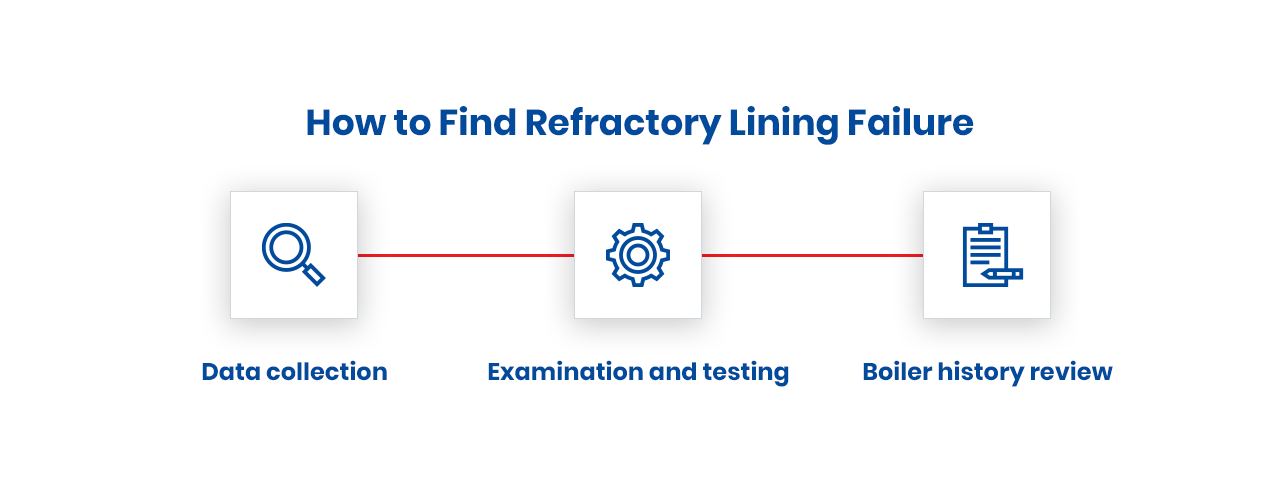When Should You Replace Refractory Materials?

Refractories are vital components in boilers and furnaces. These linings of brick and high-temperature cements act as a protective lining against the ongoing processes within a boiler’s combustion chamber, including destructive heat, abrasion and corrosion. Installing refractories correctly is essential for ensuring efficient and safe operation in both industrial and commercial boilers. However, just as important as proper installation is proper maintenance, which includes knowing when to replace key refractory materials.
What Causes Refractory Lining Wear?
Like the tires of a car, refractories wear out over time due to the damaging environment in which they operate. While wear can be minimized by following proper heat up and cool down procedures and performing simple maintenance, the refractory lining can crack, erode or otherwise get damaged for many reasons. Some of the most common causes of refractory lining wear include the following:
- Abrasion: Abrasive products like fuel, ash and other particles are often used in boiler systems. Like a sandblaster, these products will wear away at the refractory lining over time.
- Thermal cycling: Boilers and furnaces cycle in their heat production, generating massive amounts of heat up to 3,000°F before cooling off. Refractory linings, therefore, undergo the same thermal cycling, causing the refractory materials to expand and contract continuously. This results in materials such as firebricks, gaskets and fiberglass insulation degrading over time. In some cases where there is a sudden massive change in temperature called thermal shock, the rapid expansion or contraction of the material will cause more drastic and immediate damage to the refractory lining.
- Corrosion: The lining of a refractory can chemically react with materials and byproducts from the boiler. These chemical reactions can cause the refractory materials to soften or glass over, eventually resulting in surface failure.
- Erosion: Moving liquids like slag and molten metal in a boiler create a washing action against the refractory lining. Over time, this movement of liquid can erode the refractory lining, leaving the materials more prone to destruction from other causes like abrasion and corrosion.
- Mechanical wear: Moving equipment and parts in the boiler can place stress on the refractory lining, resulting in wear. Continuous mechanical wear can damage the structural integrity of the refractory lining.
- Improper materials: Sometimes, refractory materials wear down more quickly because the wrong materials were used to build the refractory. The material may not be suitable for the type of fuel being burned or the environment needed for the boiler and fuel combustion process.
- Improper installation: In some instances, a refractory owner or their hired installation team will rush the refractory installation or repair process, resulting in an improper installation. Missed or shortened steps in laying refractory bricks, choosing materials or letting the setup cure can all result in significant structural problems for the refractory.
- Improper maintenance: Another cause of refractory failure is human error in the form of improper maintenance. For example, refractories will often form “good cracks” as part of the natural cool-down process, which disappear during the heat-up process. Filling in these cracks unnecessarily can result in shell bulge and material wear since the materials will naturally expand again.
Refractory failure is one of the leading causes of boiler failures and inefficiencies, and refractory lining wear can also result in damage to other components of the boiler, such as the boiler tubes, burners and other systems. This extensive potential damage is the reason why boiler owners need to be aware of the causes of wear and implement a maintenance procedure to identify and handle wear as soon as it happens.
How to Find Refractory Lining Failure
Discovering the cause of a refractory material failure is a complex process that requires expert repair and installation personnel working in tandem with your internal team. While the process itself will look different depending on the specific qualities of your boiler plant, the process generally follows the steps below:
- Data collection: To start, have your repair crew work with your internal team to collect as much information about the refractory as possible, including details about performance changes, chemical compositions of boiler fuel being burned and material samples of slag and ash. In addition to this information, provide as much detailed information about the installation of the refractory, such as the composition and manufacturer for the materials used, the condition of the material during installation and all installation procedures and timelines used.
- Examination and testing: After collecting samples and data, a repair crew can analyze the information to determine the likely cause of wear and how to handle it. Experts will typically look for evidence of the above-listed causes of refractory lining wear to determine the primary culprits. The team will also likely run samples through various tests to verify the strength of refractory materials and the type of environment the refractory operates with.
- Boiler history review: The repair crew will also take a look at the details of a boiler refractory’s history to glean clues as to the types of repairs and replacements needed. This often involves analyzing the details of the refractory installation to determine if any errors could have compromised the refractory’s integrity. They will also take a look at the recent boiler and refractory services to determine if any changing boiler conditions or faulty repair operations may have affected the refractory.
Once the repair team has completed these steps, they will typically know the cause of the wear. From here, the team should be able to make a recommendation for the repair, whether it is replacing an insulation board or redoing the installation completely.
Maintenance Schedule for Refractory Lining
Like any essential equipment, refractory linings should undergo regular maintenance to ensure optimal operation and longevity — without proper maintenance, refractory lifespans can be reduced by 50% or more. This means that your company needs to create a thorough maintenance schedule for your refractory lining. But when should you schedule maintenance for refractory components?
The truth is that there is no one-size-fits-all approach to scheduling maintenance for refractory lining. Different types of materials and equipment require different maintenance schedules — when to replace ceramic fiber will differ from how long a gasket will last in the same environment. Depending on what materials and components are used in the refractory lining, maintenance schedules will vary widely from boiler to boiler.
The best way to set a maintenance schedule is to have a refractory engineer perform an inspection similar to the process outlined in the previous section. Using the information gathered, they can then create a custom maintenance plan for your equipment.




